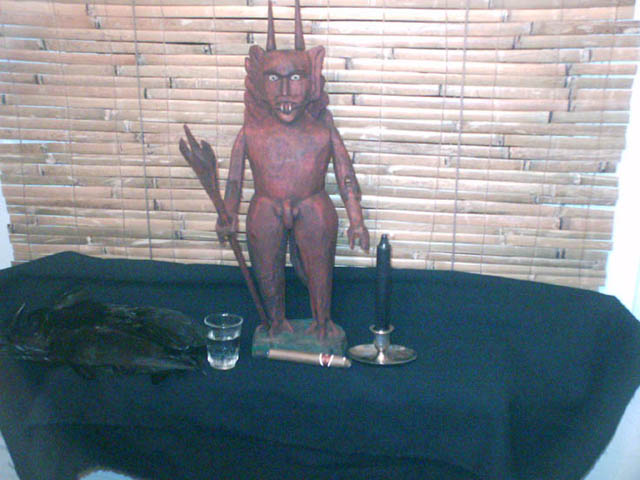
This is a model altar of those I personally use in Magia Negra this one is dedicated to Luzbel the syncretistic spirit in Mexican Magia Negra. This statue comes from Guatemala made by Brujos in Guatemala it is special because it is handcrafted by traditional indigenous people. To his right is a black candle to be lit in a petition and a cigar rests at his feet, directly left of the cigar is a shot glass with tequila. Beside this is a black rooster feather skin hackle used to self fumigate and perform cleansings with. The black rooster feathers were collected from a taxidermist and the skin is cured so that it will be a lasting magical tool. The altar is very simplistic and the actual working altar would include other elements such as a skull, obsidian or black mirror, a goat horn and other food offerings along with petitions.
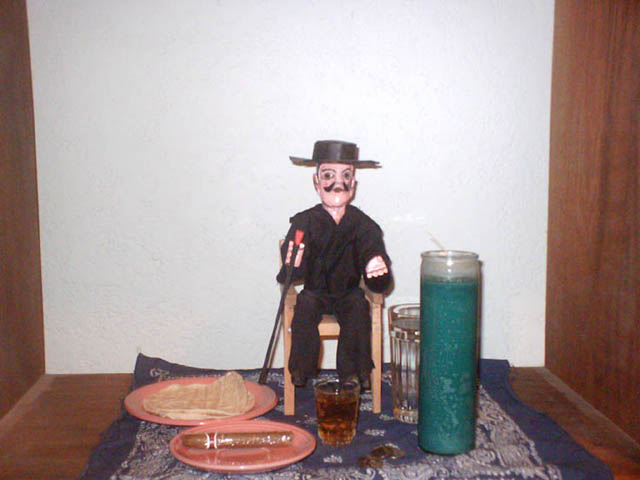
A model altar for San Simon or El Hermano Simon also known as Maximon pronounced "Masheemon". The statue is a traditional statue made in Guatemala by the Mayan people which makes it special because it comes from the Homeland of San Simon. The altar setting is one for prosperity and includes many traditional offerings to the spirit. To his left are some tortillas and in front is a cigar (he loves tobacco), right of the cigar is a shot glass with tequila; his preffered drink is aguardiente but he also likes tequila, whiskey and brandy. A more traditional drink if you can get it (or make it) would be Balche. In the forefront are some coins and a green seven day candle, behind it is a glass of water. The glass of water has a dual offering, it is a drink offering and for its symbolism of the primordial waters which he represents. The working altar would obviously include copal smoke and the cigar lit and candles burning. San Simon became adopted into Mexican Brujeria because of how close Guatemala is to Mexico which neighbors Mexico on the Chiapas zone also a Mayan populated section of Mexico. We must never forget the Mayan contribution to Brujeria in the Yucatan. If you want to know more about this spirit read my San Simon Essay
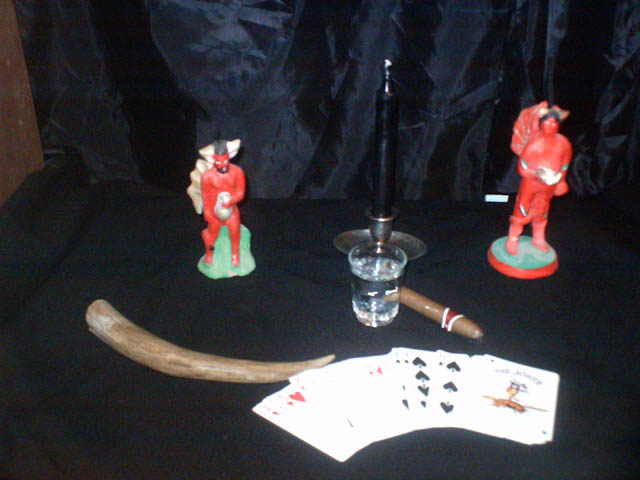
Magia Negra: This is another altar arrangement for the mysteries of Magia Negra, the ritual setting or intent is one of knowledge, power and wealth. The devil to the right is holding a book symbolic of the wisdom he has to offer, the playing cards in front are used for divination another tool for knowledge. The devil on the left is holding a bag of money representing the prosperity that is sought in the ritual, in front of him is an antler spike/horn symbolic of power. In between the devils is a black candle to be lit as an offering and a shot glass with white tequila and a cigar. These devils are ceramic and come from Mexico, the devil with the book is reminiscent of the old Mexican proverb which states "el diablo sabe mas por viejo que por ser el diablo" which means The Devil knows more because of his age, than because he is the Devil. Which means that wisdom comes through hard work and experience it is not gained by social status, reputation, or talent alone. Nothing is simply handed to us in life everything exacts a price. Blood, Sweat, Tears, Spirit..
Here's another angle of the Magia Negra altar.
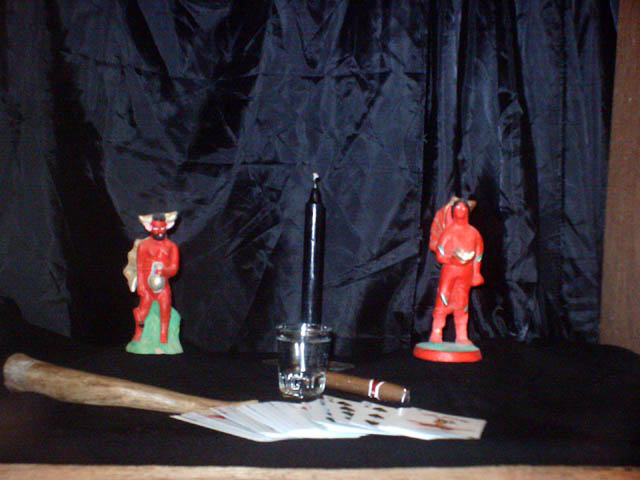
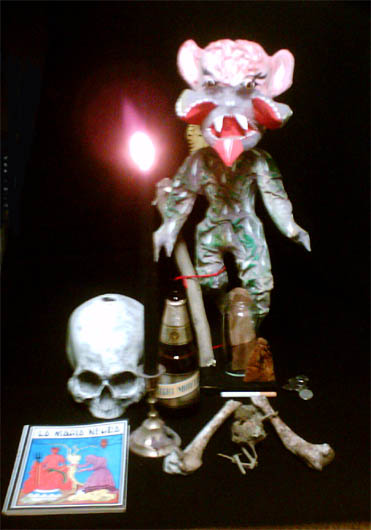
JUDAS ISCARIOT RITUAL ALTAR:
The ritual setting is for Magia Negra, at the foot of this Devil-Judas statue you see his money bag filled with his thirty pieces of silver, next to it is a jar in which petitions are written to Judas; to the right are some additional coins as a payment for the work being done. In addition you see in front of those items are Mexican Beer & Cigarette offerings to the spirit. To the left is a skull representing his death and the dead, In front of this a black candle burns and next to it are some bones and herbs to be used in preparing a spell. In the left forefront rests one of the classical Grimorios (Magia Negra) used on the altar for both its recipes and prayers in addition to its spiritual value to the forces involved. Judas Iscariot can be petitioned for all requests both benign and malign.
I have been working with San Simon for a decade now and through my essay regarding San Simon I have noted that Judas Iscariot is syncretized into his spiritual make up any Brujo that works with San Simon will tell you this. About 5 years ago I decided to explore the possibility of working with the individual aspect of Judas Iscariot himself this is because I have already experienced aspects of Judas through my workings with San Simon. In my studies I came to discover that the Brujos in Guatemala actually have a working relationship with Judas Iscariot. My personal work with the spirit draws from these studies and my own personal experiences in this aspect of Brujeria.
Although not as popular as San Simon he still plays an important role in Brujeria of Guatemala, he is petitioned for all forms of requests both good and evil.
Notes: This Judas Iscariot statue is from Mexico made of papier-mache he is 17 years old acquired from a vendor that sells collectible Mexican Folk Art. These Judas Iscariot figures are normally made into red devils, these statues are burned or blown up by fire-crackers during the Easter festival, the burning of Judas is supposed to represent to cleansing of (evil) in the world with the renewal of Spring. The figures that are blown up are stuffed with candies so that when they are destroyed the evil is gone and life becomes sweet. It is difficult to find pictures or figures that represent what the actual Judas Iscariot looked like, this is why these statues are so special, because they are made by artists who are immersed in the mythological aspects of Judas Iscariot making such statues very spiritual in their function. The artist is focused on the character of Judas Iscariot when he or she is making such a statue. This statue will have a long life in this Brujo’s home.
This is a unique figure showing reptilian features. I chose him because of the fact that it is our reptilian instincts that tap in to our more sinister human nature. I believe Judas Iscariot was well in touch with his reptilian nature to become such a historically sinister albeit misinterpreted spiritual figure.
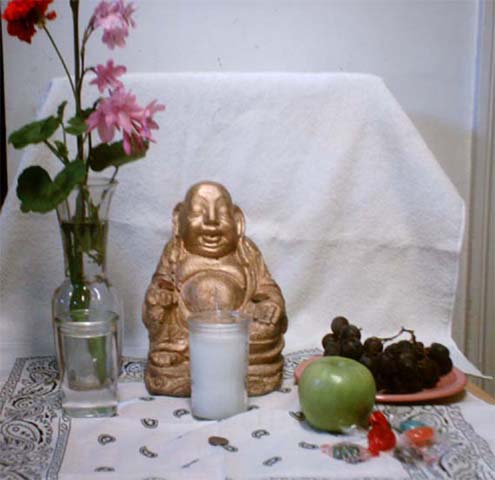
Altar para Santo Buda
(Buddha Saint Altar)
This is a model altar to the Santo Buda this is the happy Buddha he is the Oriental Santo in Brujeria and is venerated with the same love and respect shown to all the other Santos of Brujeria culture. Note the fruit, candle, candies, coins and floral offerings.
Around 17 years ago when I started my path into the practice of Brujeria I first encountered Santo Buda in one of the many Botanicas in Los Angeles, the Botanica in the Barrio I lived had a Santo Buda altar and glass 7 day candles to the saint. I asked the co-proprietor of the shop with the curious enthusiasm of my early years, why they had a Chinese statue in their shop? To which she replied “es el santo chino de la Buena suerte, y todos necesitamos buena suerte” which means he is the Chinese Saint of good luck and we all need good luck. Which sounded good to me and although I didn’t own a statue of the santo I started to burn the candles dedicated to the santo; true to his fame, good fortune always smiled on me.
Santo Buda is petitioned for Good Fortune in all aspects i.e. wealth, health, love, happiness; he is also sought for guidance and wisdom and protection. Santo Buda is an import to Mexico, Guatemala, Central America and parts of South America and the Spanish speaking world.
He was introduced in Mexico during the time that the Spaniards established trade with the Chinese. Varying aspects to the way in which Santo Buda is worked with by Brujos in Mexico and Guatemala exist but are too in depth to mention in this display.
Of special Note: Buddha's origins started in Northern India and there are references to some Hindu deities in the old Grimorios, although Buddha is not a Hindu deity it is possible he was known to the Spaniards prior to trade with the Chinese, as this is not confirmed it is only a speculation it is not presented as historical fact. What is historically accurate is the Chinese introduction of Buddha in Mexico during the colonial trade era of Mexico.
Important Note regarding the altar arrangement
One thing some would be scholars (not all mind you), fail to express about the Brujeria culture of Mexico are the indigenous concepts involved in the reverence for the Saints. Although the friars assumed a total conversion of the Mexica and related tribal groups they did not quite understand a very important principle that is also shared by the Maya and related tribes. The Mexica were a very syncretistic people who readily adopted the deities of their neighboring people and those that they conquered. This same philosophy carried over during post conquest era when the Spanish friars, were converting the Indigenous people of Mexico. They failed to understand the basic meanings in which the Indigenous people viewed the Gods of which they came to include the saints and how they applied their own spiritual philosophy.
The offering of flowers, copal and libation was a very common practice in Mexica society, the basic altars that indigenous Mexicans kept in their homes. Evidence of these basic practices is available in records kept by the Holy inquisition; Alarcon is a good reference here. One record relates to the veneration of the Ololiuqui and statues of the Gods, how they were kept on an altar with flowers, copal fumigation and libation. These same concepts were transferred over into the reverence of the saints, these indigenous concepts were overlooked by the friars who deemed the offerings i.e. copal, flowers, pulque etc, as indigenous ignorance. In other words these ideas were written off in the minds of the friars as an assumption that the (Indigenas) were merely accommodating the beliefs of their converters. A more in depth essay regarding the syncretism will be forthcoming.